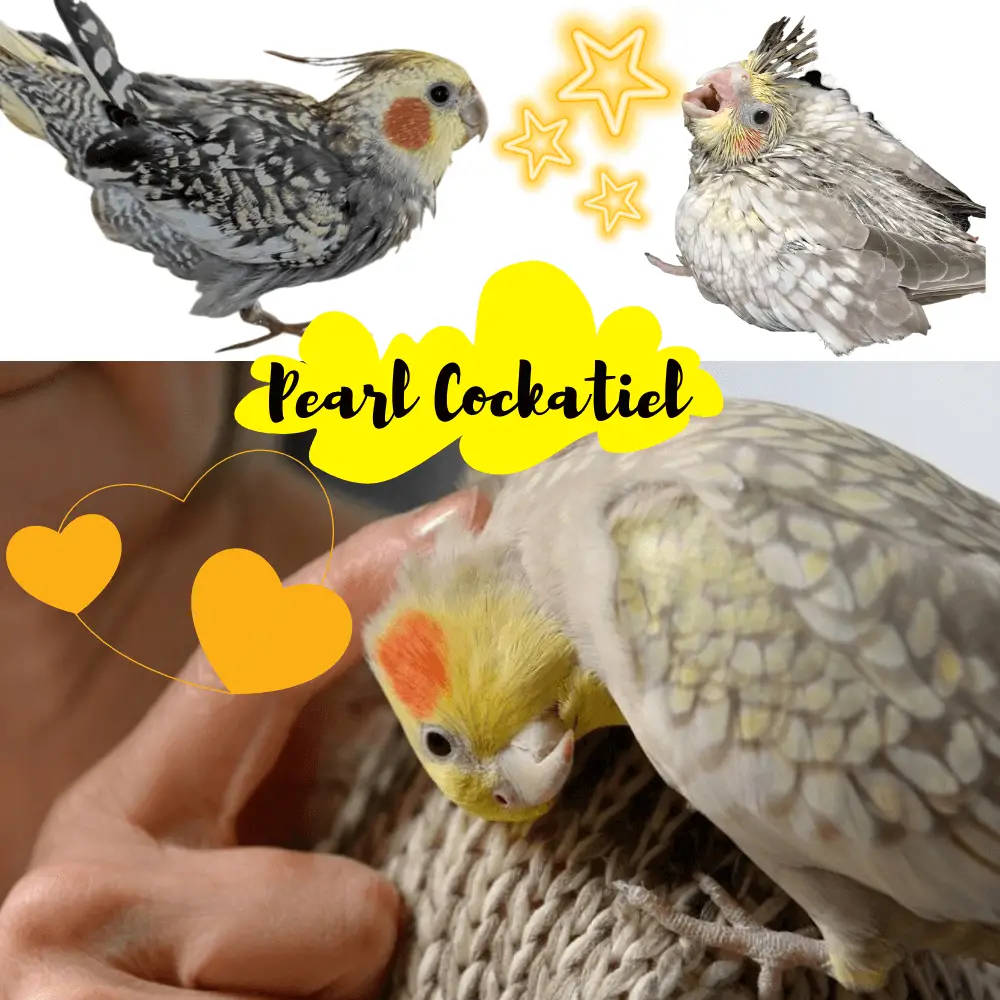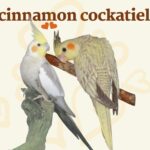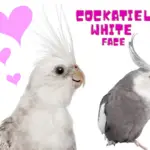
This mutation Pearl cockatiel or Pearl cinnamon cockatiel is always in the “supplement” of another and is characterized by pearls on the back. The simplest cockatiel mutation combination is wild-type opaline. It is impossible to detect the gender of young cockatiels and sexing the cockatiel cinnamon pearl. The males are recognizable because they lose their pearls from their first molt. There are other combinations, such as variegated opaline, cinnamon opaline, or white opaline face.
Opaline or pearl mutation
The pearl or opaline cockatiel mutation sex-related recessive mutation is very often in “supplement” with another and is characterized by pearls on the back.
The cockatiel opalines are all different with more or less cockatiel pearl, we talk about good or bad beading. It is impossible to sex with young cockatiel subjects with this mutation without knowing the cockatiel’s parents.
Opaline Cockatiel
Chicks are born with yellow down and dark eyes
Opaline is a local reduction of melanin.
The feather is devoid of color, except in its center and on the edges which are gray
the mask and the crest are yellow in the male and greenish in the cockatiel female and end in gray on the top of the crest.
The beak is dark horn-colored, the legs greyish and the nails are dark grey. The eyes are black
Pearl cinnamon cockatiels
All you need to know about cockatiel pearl mutation
Pearl Cockatiel Hoopoe
The crest is gray in color but there are some pale yellow shades at the roots of the feathers on the forehead.
At their roots, the feathers of the hoopoe are the same yellow color as those of the head. The longest crest feathers may turn slightly gray towards their tips.
Pearl Cockatiel Head
In the ear region, there is a round orange-red spot (called mumps) 1.5 centimeters in diameter. The cockatiel color is duller than in the cockatiel pearl male.
Although this mumps is circular in shape and requires delineation in the Pearl cockatiel male, the Pearl cockatiel female standard tolerates small yellow and gray encrustations on the outer periphery of this mumps. This tolerance excludes any significant indentations.
In the ear region, there are around orange-red spots 1.8 centimeters in diameter. This region should also be clearly demarcated from the yellow color of the head and not have any encrustation. The orange-red color must be uniform and well-contrasted.
The space covering the underside of the eye up to the cheeks and between the beak and the mumps is yellow and gray in color. The space running from the top of the nostrils to the eye contour is also yellow and gray in color.
The Upper and back of the head form a narrow dark gray band behind the crest.
This band widens along each side of the head following the orange-red color and joins on the neck. The color is dark gray on the back of the head and lighter gray on the chest without any encrustation. Depigmentations of melanin on these coverts, giving an image of white water drops, are present.
Pearl cinnamon cockatiels

Pearl Cockatiel Nape, Back, Rump, Sus-Caudales
All these areas should be dark gray in color with depigmentation of the feathers. The alternation of melanins and psittacines (white or yellow) should produce a drawing hemmed with a very fine border on each feather.
The drawing is in a half-moon on the coverts of the neck then it “becomes oval” gradually as it gains the back.
The rump is streaked with gray and white (or yellow). The upper tail is almost depigmented.
Pearl Cockatiel Wings
Pearl cockatiel wing feathers (coverts and flight feathers) are hemmed in dark gray except for a depigmented wing band that borders the outside of part of the wing (when it is at rest).
This band originates at the wing joint, runs along the wing at the fold-over 1.8 to 2 centimeters wide, and ends on the secondary flight feathers. The design of pearl cinnamon is gradually and symmetrically “ovalized” by gaining more and more flight feathers: tertiary, secondary, and primary. The margins of the primary flight feathers are dark gray.
The elongated pattern of the wing strip must be regular, without any indentation with the dark gray color of the wing. The color must be white; some light yellow suffusions are accepted.
Pearl Cockatiel Chest, Belly, Panties, Underside
These areas are gray, with small rounded white beads on the chest. Yellow inlays on the belly are accepted in small quantities and provided that their design is regular and symmetrical.
Pearl Cockatiel Tail
The tail is light yellow except for a gray tip at their ends and the rachis of the rectrices. Some regular gray and yellow hatching is accepted on the underside of the tail.
Legs, Fingers, and Nails: The legs and feet are gray. The nails are black.
Pearl Cockatiel’s eyes
The peak cockatiel eyes is grey and dark.
Pearl Cockatiel Beak
The Pearl cockatiel beak is Grey.

Pearl cockatiel price
How much does a pearl cockatiel cost: The Pearl cockatiel price costs $150 to $200
Pearl cockatiel Nutrition
The pearl cinnamon cockatiel is a mainly granivorous bird, but it enjoys all kinds of foods like fruits and even vegetables. In this article, we will see in more detail what makes up his diet, as well as a list of authorized fruits and vegetables.
The diet you feed your cockatiel should always be varied, as a bird in captivity will spend much of its time, just as it would in the wild, looking for food. Monotonous food will therefore have a negative impact on your bird’s mental health. Many budgies tend to sort and send a good portion of their seeds to the bottom of their cage. So let them peck at the fallen seeds for a while before re-filling their feeder: this keeps them busy and contributes to their psychological balance. Be careful not to leave their feeder empty for too long! To perfect the mental balance of your opaline cockatiel, also think about the different toys! see more about cockatiel toys ideas
Seeds for pearl cockatiels
We find in the diet of the cockatiel mainly small grasses and some larger seeds to distribute sparingly because fatter and more energetic.
- Canary seed: small brown seed rich in protein. It is the basis of a healthy diet for most birds because it is very balanced.
- Millet: there are several varieties of colors. Millet is quite poor but has the advantage of being able to be distributed in clusters. The cockatiels love them because they then have the pleasure of dissecting them themselves.
- Oats: seed quite rich in energy. You can add it to your mixture, but without overdoing it.
- Sunflower: This seed is very popular with pearl cockatiel, but must be present in small quantities because it is very rich in energy and quite fat.
- Other seeds can still complement your blends such as buckwheat and flax.
Of course, you can buy these mixtures already prepared and in adequate proportion.
Fruit for pearl cockatiels
Cockatiels bird love fruit, and this gives you a good opportunity to socialize with your bird, in addition to varying its food. Be careful to remove the seeds because they may contain poison for your pet.
Fruits should be distributed in small quantities because they contain sugar and can cause diarrhea.
Here is the list of recommended fruits.
- pineapple
- banana
- cherry
- fig
- strawberry
- raspberry
- Passion fruit
- Grenada
- kiwi
- lychee
- melon
- wild blackberries
- blueberry
- coconut
- orange
- papaya
- watermelon
- fishing
- pear
- apple
- plum
- grape
- raisin
Vegetables for pearl cockatiels
More and more breeders supplement the parrot diet of their birds with vegetables, because the seeds given alone are often too fat and too rich in energy for a bird in captivity, especially if it does not have the opportunity to spend flying regularly. Attention: if you want to introduce vegetables into the diet of your pearl cinnamon cockatiel, be sure to do it gradually to allow its digestive system to adapt.
It is possible that your bird “plays” with the pieces of vegetables rather than eating them. In this case, you can try to mix them in their seeds, as long as they are not “juicy” vegetables.
Vegetables are, like fruits, to be distributed sparingly to avoid diarrhea.
Here is the list of recommended vegetables
- artichoke
- beet
- broccoli
- carrot
- celery
- chicory
- collard greens
- pumpkin
- cucumber
- squash
- courgette
- endive
- spinach
- fennel
- French bean
- lettuce
- corn on the cob
- turnip
- sweet potato
- green peas
- Leeks
- pepper
- pumpkin
- tomato
Food supplements for Pearl cockatiels
In addition to the parrot foods we have just mentioned, there are a series of supplements that you should make available to your pearl cockatiel.
The first, and best known, is the cuttlefish bone which is an indispensable element, to be distributed without moderation for the following reasons:
- Large contribution of calcium, essential to your bird (especially during the laying period for females).
- Maintenance of the spout of your pearl cinnamon cockatiel
- Satisfy his destructive instinct: she will be happy to tear him to pieces!
You can find cuttlefish bones in pet shops and on the internet: Buy cuttlefish bones on Amazon.
Minerals are naturally present in fruits and vegetables, but if your bird doesn’t eat enough, you can find supplements in several forms: bulk pecking and powdered (mixed with the seeds).
How long does a Pearl cockatiel live
How long does a pearl cockatiel live: The pearl Cockatiel’s lifespan varies on average between 15 and 20 years. with a very good quality of life and cockatiel care and food and diet health and nutrition and much love, she can sometimes even live up to 30 years.
Pearl cockatiel male or female

Males Pearl Cockatiel
Males Pearl Cockatiel are recognizable because they begin to lose their pearls from their first molt, and will therefore look (for simple opaline) like a wild type. There are multitudes of combinations with opaline, such as variegated opaline, opaline cinnamon or white face opaline, etc…
All mutations can combine together.
Here are two pictures: on the right male an opaline pale face who has lost the pearls on his back, we see slight traces still. On the left female opaline (pearl).
Female Pearl Cockatiel
This description of the Pearl cockatiel Mutation standard is written from a female Pearl cockatiel that has completed its adult molt.
In italics, the physical characteristics of the Pearl cockatiel male in juvenile plumage will appear.
The breeder who presents males accepts the risk of being penalized in the competitions.
Pearl cockatiel male-female difference
SOURCE: Denny the Budgie
Related Articles
- Hand feeding cockatiel
- How to set up a cockatiel cage
- Cockatiel diarrhea
- Cockatoo vs cockatiel
- Difference between cockatoo and cockatiel
- Adopting a cockatiel all you need to know
- Cockatiel origin and physiology
- Cockatiel emergencies
- Cockatiel lesions injuries and masses
- Cockatiel treatment and preventive care
- Cockatiel pecking
- Cockatiel behavior
- Cockatiel anatomy
- Cockatiel bites





















